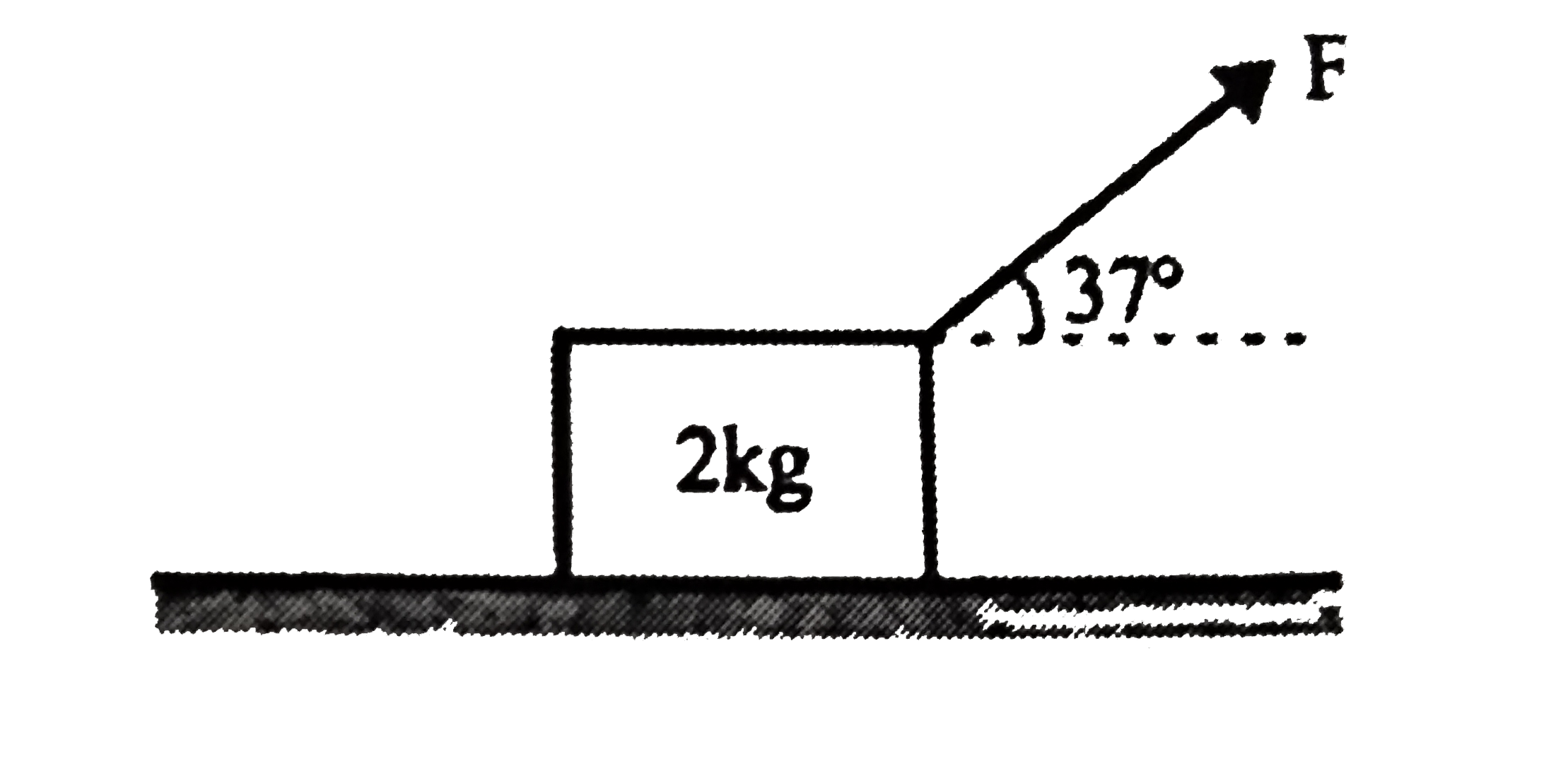A body of mass 10 kg is placed on rough surface, pulled by force F making an angle of 30∘ above the horizontal. If the angle of friction is also 30∘, then the minimum magnitude of force F required to move the body is equal to ( take, g=10ms−2)
100 N
50√2N
100√2N
50N
The correct Answer is:D
To solve the problem, we need to find the minimum force F required to move a body of mass 10kg on a rough surface when the force is applied at an angle of 30∘ above the horizontal. The angle of friction is also 30∘.
Step 1: Identify the forces acting on the body
- The weight of the body W=mg=10kg×10m/s2=100N acts downwards.
- The normal force N acts perpendicular to the surface.
- The applied force F can be resolved into two components:
- Horizontal component: Fcos(30∘)
- Vertical component: Fsin(30∘)
Step 2: Write the equations for vertical forces
The vertical forces must balance for the body to move:
N+Fsin(30∘)=mg
Substituting the known values:
N+F⋅12=100
Thus, we can express the normal force N:
N=100−F2
Step 3: Determine the frictional force
The frictional force f can be expressed using the normal force and the coefficient of friction. The coefficient of friction μ is given by:
μ=tan(30∘)=1√3
The frictional force f is:
f=μN=1√3N
Substituting for N:
f=1√3(100−F2)
Step 4: Set up the equation for horizontal forces
For the body to just start moving, the horizontal component of the applied force must equal the frictional force:
Fcos(30∘)=f
Substituting the known values:
F⋅√32=1√3(100−F2)
Step 5: Solve for F
Now we can solve for F:
F⋅√32=100√3−F2√3
Multiplying through by 2√3 to eliminate the fractions:
F⋅3=200−F
Rearranging gives:
3F+F=200
4F=200
F=50N
Conclusion
The minimum magnitude of force F required to move the body is 50N.
---
- The weight of the body W=mg=10kg×10m/s2=100N acts downwards.
- The normal force N acts perpendicular to the surface.
- The applied force F can be resolved into two components:
- Horizontal component: Fcos(30∘)
- Vertical component: Fsin(30∘)
The vertical forces must balance for the body to move:
N+Fsin(30∘)=mg
Substituting the known values:
N+F⋅12=100
Thus, we can express the normal force N:
N=100−F2
The frictional force f can be expressed using the normal force and the coefficient of friction. The coefficient of friction μ is given by:
μ=tan(30∘)=1√3
The frictional force f is:
f=μN=1√3N
Substituting for N:
f=1√3(100−F2)
For the body to just start moving, the horizontal component of the applied force must equal the frictional force:
Fcos(30∘)=f
Substituting the known values:
F⋅√32=1√3(100−F2)
Now we can solve for F:
F⋅√32=100√3−F2√3
Multiplying through by 2√3 to eliminate the fractions:
F⋅3=200−F
Rearranging gives:
3F+F=200
4F=200
F=50N
The minimum magnitude of force F required to move the body is 50N.
Topper's Solved these Questions
- BOOK - DC PANDEY ENGLISHCHAPTER - LAWS OF MOTIONEXERCISE - Chapter exercises (A) Taking it together71videos
LAWS OF MOTION
- BOOK - DC PANDEY ENGLISHCHAPTER - LAWS OF MOTIONEXERCISE - Match the columns7videos
LAWS OF MOTION
- BOOK - DC PANDEY ENGLISHCHAPTER - LAWS OF MOTIONEXERCISE - Check point 5.320videos
LAWS OF MOTION
- BOOK - DC PANDEY ENGLISHCHAPTER - KINEMATICS 1EXERCISE - INTEGER_TYPE15videos
KINEMATICS 1
- BOOK - DC PANDEY ENGLISHCHAPTER - LAWS OF THERMODYNAMICSEXERCISE - Level 2 Subjective18videos
LAWS OF THERMODYNAMICS
Similar Questions
If a pushing force making an angle α with horizontal is applied on a block of mass m placed on horizontal table and angle of friction is β, then minimum magnitude of force required to move the block is
View SolutionA block of mass 10 kg is placed on the rough horizontal surface. A pulling force F is acting on the block which makes an angle θ above the horizontal. If coefficient of friction between block and surface is 43 then minimum value of force required to just move the block is (g=10ms2)
View SolutionA body of mass 5×10−3 kg is launched upon a rough inclined plane making an angle of 30∘ with the horizontal. Obtain the coefficient of friction between the body and the plane if the time of ascent is half of the time of descent.
View SolutionA block of mass 2 kg is kept on a rough horizontal floor an pulled with a force F. If the coefficient of friction is 0.5. then the minimum force required to move the block is :-
 View Solution
View SolutionA block of weight 200N is pulled along a rough horizontal surface at constant speed by a force 100N acting at an angle 30∘ above the horizontal. The coefficient of friction between the block and the surface is
View SolutionA body of mass 2 kg is projected at 20 ms−1 at an angle 60∘above the horizontal. Power due to the gravitational force at its highest point is
View SolutionA block of mass 2 kg rests on a rough inclined plane making an angle of 30° with the horizontal. If μS=0.6 , what is the frictional force on the block ?
View SolutionA block of mass m is placed at rest on a horizontal rough surface with angle of friction ϕ. The block is pulled with a force F at an angle θ with the horizontal. The minimum value of F required to move the block is
View SolutionA block of mass m is placed at rest on a horizontal rough surface with angle of friction ϕ. The block is pulled with a force F at an angle θ with the horizontal. The minimum value of F required to move the block is
View SolutionA body of mass 10kg is on a rough inclined plane having an inclination of 30° with the horizontal. If coefficient of friction between the surfaces of contact of the body and the plane is 0.5. Find the least force required to pull the body up the plane.
View Solution

